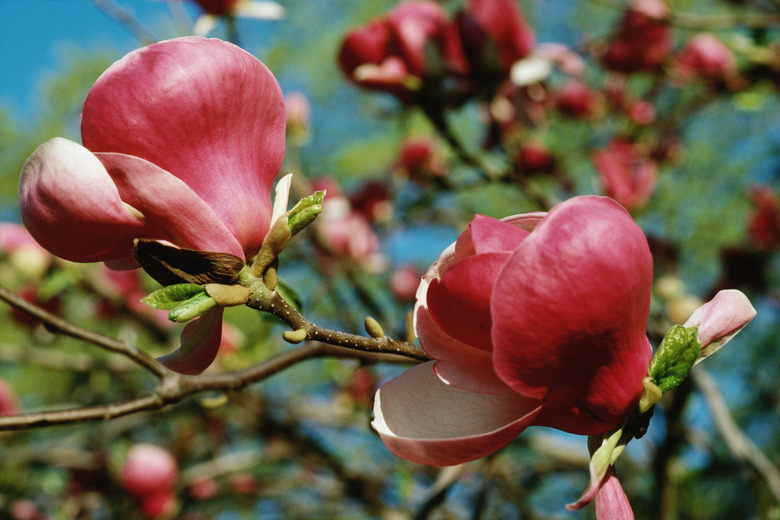What Causes White Spots On Magnolia Leaves?
Magnolias are a genus of flowering shrub or tree that produces vibrant flower growth when in bloom. White spots on magnolia leaves can be an indication of several diseases and pests that reduce the vitality of the blossoms and plant vigor. Adequate plant spacing helps prevent problems and early identification and control measures help reduce the severity of them.
Powdery Mildew
Powdery Mildew
Powdery mildew is a common, but minor fungal infection of magnolias that creates white spots of the foliage. The fungus favors warm daytime temperatures and cool nighttime temperatures for infection. While most fungal infections favor water on leaf surfaces, powdery mildew fungi favor dry surfaces and cannot infect wet leaves. The disease starts out as small white spots on leaf surfaces that enlarge as the disease progresses, creating a powdery white coating over the entire surface of the infected foliage. Severe infections can cause stunting of new foliage growth, leaf curling and premature leaf drop. Rub or spray water on infected leaves to remove the fungi, prune dead branches and remove severely infected leaves to prevent the disease from spreading. Chemical fungicides can help prevent and control severe infections.
Algal Leaf Spot
Algal Leaf Spot
Algal leaf spot is a common disease of magnolias grown in warm, humid climates. The algal pathogen favors weakened plants for infection, with symptoms appearing as superficial to minor. Symptoms of infection consist of small white to gray spots on leaf surfaces, localized leaf tissue death, leaf yellowing and premature leaf drop. Remove and destroy infected leaves to prevent the infection from spreading. Copper-based fungicides provide an effective method of control for severe algal leaf spot infections.
False Oleander Scale
False Oleander Scale
The false oleander scale is a small armored scale insect pest that feeds on magnolia foliage. Scales are white in color and cluster in colonies on plants foliage, giving the appearance of small white spots on leaf surfaces. Symptoms of infection consist of visible scales on leaf surfaces, chlorosis or dead spots where the scales are feeding, leaf yellowing and premature leaf drop. Management of false oleander scales is difficult because of the scales armor. Insecticides and horticultural oils are effective for controlling immature scales. Always check insecticide labels before using because non-target insecticides can kill predatory insects that feed on the scale, thus increasing the pest population.
Magnolia Scale
Magnolia Scale
Magnolia scale is a large insect pest that feeds on the sap of magnolia foliage. Symptoms of infection consist of white to gray scale insect movement, honeydew deposits, leaf yellowing, premature leaf drop and plant death. Scale secretes honeydew when feeding on the magnolia, which leads to sooty mold growth and an increase in other insect populations that feed on honeydew. Maintain plant vigor with regular watering and pruning to prevent scale infections. Horticultural oils, chemical insecticides and insecticidal soaps are effective methods of control.
References
- Clemson University Cooperative Extension; Magnolia; Debbie Shaughnessy, et al.; May 1999
- University of Illinois Extension; Powdery Mildews of Ornamentals; 1987
- University of Arkansas Cooperative Extension Service; Algal Leaf Spot of Magnolia; Stephen Vann
- University of Florida IFAS Extension; False Oleander Scale; Avas B. Hamon, et al.; 2009
- University of Kentucky College of Agriculture; Magnolia Scale; Lee Townsend; March 2005
